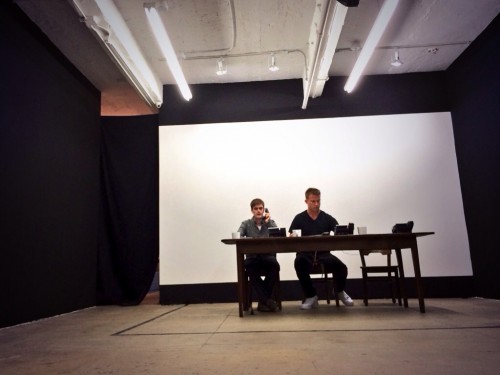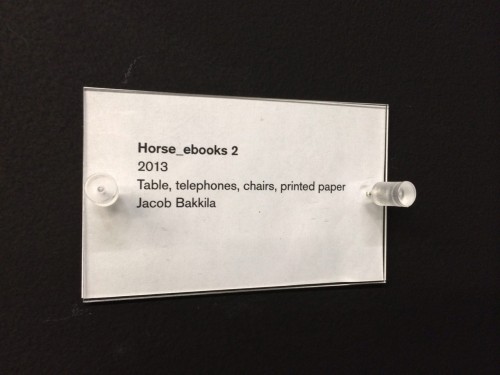what’s a bot and what’s human and where do we draw the line and should we draw that line
Yesterday, we learned that the most infamous Weird Twitter account, @Horse_ebooks, wasn’t a algorithmically-programmed “bot” but instead the product of a person tweeting as if. The revelation was accompanied by a live performance of the account in a Manhattan art gallery. While much is being written about the account, I’d like to share one thought about the live performance and what this all says about what is real and virtual, “bot” and human. In one day, @Horse_ebooks went from bot to human, and as I’ll argue, embodied in an art gallery, right back towards bot.
I’ll defer to the many other pieces about the history of @Horse_ebooks and the deeply emotional reactions people are having after learning things aren’t as bot as they seem. In fact, my favorite explanation for this came from Sarah just this morning on this blog, arguing that when horse was a bot, we got to supply the meaning, that made us feel good, and when the noise turned out to be signal, we lost our the credit for creating the signal. But let’s also bring the live-performance into this discussion, and I think it complicates things a bit in an interesting way.
The first step was revealing that the bot was human. Of course, a bot is always partially human, programmed by a person with a body and feelings and politics and standpoint and interests which is dumped into a world where it is (mis)understood by other humans. But a bot is very differently human because what it produces can diverge greatly from the human intentionality behind it. This massive difference in degree becomes, for practical reasons, a difference in type; bots aren’t devoid of humanity, but they are still very different, and that’s why the revelation that @Horse_ebooks wasn’t that different matters so much to people. So, yes, the technical is always deeply human, but the live-reading yesterday made the reverse point, that which is normally described as human is also deeply technical, virtual. Things like social norms, language, identities are technologies. Standing in the gallery watching the reading yesterday was to me an effort to make @Horse_ebooks algorithmic again.
If the fun of the Twitter account performance piece was that it queered the machine/human line by passing a sort-of reverse Turing Test, the live-reading of @Horse_ebooks played with that line in a different way. It was an intentional failing at the traditional Turing Test by purposefully taking that which is human and perform it as bot.
My critique of digital dualism is not just that what we call “virtual” is very real but also what we call “real” is also always highly virtual. The art gallery is a good example: The idea of a gallery is to create a tool premised on delineating what is and isn’t art, an architecture that deeply structures our actions, the intense performativity of us-actors in that space all create a highly simulated environment.
After revealing the bot to be human, @Horse_eBooks was mechanistically performed in a space more virtual than Twitter. Phones placed on a desk rang and our actors pretended to answer them, robotically reading the short tweets. The performance amplified the inhuman, the monotone reading, the lack of emotion shown despite the crowd’s laughter, the extra-human feat of sitting there and reading the tweets all day like only web-crawler bots usually do.
No one cares about my opinion if this is “good” art or not, but I will say that it at least arrives precisely at the question of how we should understand humans and technology. It plays within the framework of digital dualism by pushing at this assumed boundary, troubling its foundations, or at least making them more visible. A Twitter account robot does little to subvert the socially-constructed line between the human and technical but physically embodying such virtuality certainly does. If a bot is human, than a human is bot. For me, the @Horse_ebook revelation and performance at first seemed like the triumph of the human over the bot — and concluded as anything but.
Nathan is on Twitter [@nathanjurgenson] and Tumblr [nathanjurgenson.com].



Comments 4
Atomic Geography — September 25, 2013
For me this recalls a Heideggerian Enframing/Insight process. Modern tech challenges humans in such a way as to make us part of the standing reserve, the power and resources it needs to continue. Human insight provides a way out of this back to the "splendor of radiant appearing".
The whole process you describe is one of creating a picture of the situation. At each turn, the picture is undermined, creating another picture. Heidegger identifies art as providing just such an insight function for modern humans.
Using your terms, I think one could argue that Heidegger says that while pre-modern technology was deeply human, modern humans are deeply technological. The performance of horse on stage provides an opportunity for insight, a deframing of the human out of the standing reserve.
I have some additional thoughts about this starting at http://atomicgeography.com/2013/08/16/scientific-brains-bringing-it-forth/
Beating A Dead Horse » Cyborgology — September 27, 2013
[...] Horse_ebooks isn’t the bot we were hoping for; it’s a human after all. Nathan describes the performance as “a person tweeting as if” it were a bot. This formulation is really [...]
Adele — October 1, 2013
I find your art gallery analogy to be very interesting regarding this topic. The idea of the art gallery delineating what is art and what isn't, thus generating the simulated environment you say is similar to "virtual," is true to an extent. Being involved in the arts, however, I tend to believe that art is everywhere, and that a gallery is only there to showcase specific art. Even with this belief, though, the rest remains the same. Art is everywhere, everywhere is art. "If a bot is human, than a human is bot." Looking at @Horse_ebooks, I agree that digital dualism is limited in only saying that what is "virtual" is real. Being created by people, typically for people, how could one create something totally separate and outside humanity? Conversely, we couldn't identify something apparently so different from life unless we had some starting reference point. I wonder to what extent digital dualism can be defended, though, if it goes both ways- meaning they are more similar than different. It seems more like issue is a venn diagram of overlapping "sides" rather than a complete duality of what is defined as "real" and "virtual."
What would I say? | This is important. — November 13, 2013
[…] self, choose to share with my friends? More bots and writing about bots: Two Headlines Of Bots and Humans Unfortunately, as you probably already know, people and perhaps my favorite bot: Stealth […]